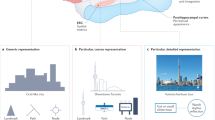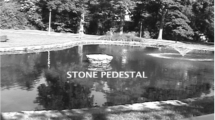Abstract
Human navigation in well-known environments is guided by stored memory representations of spatial information. In three experiments (N = 43) we investigated the role of different spatial reference systems when accessing information about familiar objects at different locations in the city in which the participants lived. Our results indicate that two independent reference systems underly the retrieval of spatial knowledge. Environmental characteristics, e.g., the streets at an intersection, determine which headings are easier to imagine at a given location and lead to differences in accessibility of spatial information (orientation-specific behavior). In addition, access to spatial information depends on the relative direction of a location with respect to the imagined heading, such that information about locations imagined in front of oneself is easier to access than about locations towards the back. This influence of an egocentric reference system was found for environmental knowledge as well as map-based knowledge. In light of these reference system effects, position-dependent models of spatial memory for large-scale environments are discussed. To account for the simultaneous effect of an environmental and an egocentric reference system, we present a 2-level model of spatial memory access.
Similar content being viewed by others
References
Berthoz, A. (1991). Reference Frames for the Perception and Control of Movement. In J. Paillard (ed.), Brain and Space. New York: Oxford University Press, pp. 81–111.
Bisiach, E. and Luzzatti, C. (1978). Unilateral Neglect of Representational Space, Cortex 14: 129–133.
Byrne, R.W. (1979). Memory for Urban Geography, Quarterly Journal of Experimental Psychology 31: 147–154.
Franklin, N. and Tversky, B. (1990). Searching Imagined Environments, Journal of Experimental Psychology: General 119: 63–76.
Golledge, R.G. (1999). Human Wayfinding and Cognitive Maps. In R.G. Golledge (ed.), Wayfinding Behavior: Cognitive Mapping and Other Spatial Processes. Baltimore: Johns Hopkins University Press, pp. 5–45.
Golledge, R.G. and Stimson, R.J. (1997). Spatial Behavior: A Geographic Perspective.New York: Guilford Press.
Hintzman, D.L., O'Dell, C.S. and Arndt, D.R. (1981). Orientation in Cognitive Maps, Cognitive Psychology 13(2): 149–206.
Hirtle, S.C. and Jonides, J. (1985). Evidence of Hierarchies in Cognitive Maps, Memory and Cognition 13: 208–217.
Ittelson, W.H. (1970). Perception of the Large-scale Environment, Transactions of the New York Academy of Sciences, Series II 32(7): 807–815.
Klatzky, R.L. (1998). Allocentric and Egocentric Spatial Representations: Definitions, Distinctions, and Interconnection. In C. Freksa, C. Habel and K.F. Wender (eds.), Spatial Cognition: An Interdisciplinary Approach to Representing and Processing Spatial Knowledge. Berlin: Springer, pp. 1–17.
Kosslyn, S.M. (1994). Image and Brain. Cambridge: MIT-Press.
Levine, M., Jankovic, I.N. and Palij, M. (1982). Principles of Spatial Problem Solving, Journal of Experimental Psychology General 111(2): 157–175.
Levinson, S.C. (1996). Frames of Reference and Molyneux's Question: Crosslinguistic Evidence. In P. Bloom, M.A. Peterson, L. Nadel and M.F. Garrett (eds.), Language and Space: Language, Speech and Communication. Cambridge, MA: MIT Press, pp. 109–169.
Loomis, J.M., da Silva, J.A., Fujita, N. and Fukusima, S.S. (1992). Visual Space Perception and Visually Directed Action, Journal of Experimental Psychology Human Perception and Performance 18(4): 906–921.
McNamara, T.P., Hardy, J.K. and Hirtle, S.C. (1989). Subjective Hierarchies in Spatial Memory, Journal of Experimental Psychology: Learning, Memory, and Cognition 15: 211–227.
Montello, D.R. (1991). Spatial Orientation and the Angularity of Urban Routes: A Field Study, Environment and Behavior 23(1): 47–69.
Poucet, B. (1993). Spatial Cognitive Maps in Animals: New Hypotheses on Their Structure and Neural Mechanisms, Psychological Review 100(2): 163–182.
Presson, C.C. and Hazelrigg, M.D. (1984). Building Spatial Representations through Primary and Secondary Learning, Journal of Experimental Psychology: Learning, Memory, and Cognition 10: 716–722.
Rieser, J.J. (1989). Access to Knowledge of Spatial Structure at Novel Points of Observation, Journal of Experimental Psychology: Learning, Memory, and Cognition 15: 1157–1165.
Roskos-Ewoldsen, B., McNamara, T.P., Shelton, A.L. and Carr, W.S. (1998). Mental Representations of Large and Small Spatial Layouts are Orientation-Dependent, Journal of Experimental Psychology: Learning, Memory & Cognition 24: 215–226.
Schölkopf, B. and Mallot, H.A. (1995). View-Based Cognitive Mapping and Path Planning, Adaptive Behavior 3(3): 311–348.
Shelton, A.L. and McNamara, T.P. (1997). Multiple Views of Spatial Memory, Psychonomic Bulletin & Review 4: 102–106.
Shelton, A.L. and McNamara, T.P. (submitted). Systems of Spatial Reference in Human Memory.
Shepard, R.N. and Cooper, L.A. (1982). Mental Images and Their Transformations. Cambridge, MA: MIT Press.
Sholl, M.J. (1987). Cognitive Maps as Orienting Schemata, Journal of Experimental Psycho-logy: Learning, Memory, and Cognition 15: 110–125.
Sholl, M.J. (1995). The Representation and Retrieval of Map and Environment Knowledge, Geographical Systems 2: 177–195.
Sholl, M.J. and Nolin, T.L. (1997). Orientation Specificity in Representations of Place, Journal of Experimental Psychology: Learning, Memory, and Cognition 23(6): 1494–1507.
Stevens, A.L. and Coupe, P. (1978). Distortions in Judged Spatial Relations, Cognitive Psychology 10: 422–437.
Tarr, M.J. (1995). Rotating Objects to Recognize Them: A Case Study on the Role of Viewpoint Dependency in the Recognition of Three-Dimensional Objects, Psychonomic Bulletin and Review 2(1): 55–82.
Tversky, B. (1981). Distortions in Memory for Maps, Cognitive Psychology 13: 407–433.
Wang, R.F. (1999). Representing a Stable Environment by Egocentric Updating and Invariant Representation, Spatial Cognition and Computation 1(4): 431–445.
Werner, S (in preparation). The Effects of Egocentric and Allocentric Frames of Reference on the Mental Representation of Extrapersonal Space.
Werner, S., Krieg-Brückner, B. and Herrmann, T. (2000). Modelling Navigational Knowledge by Route Graphs. In C. Freksa and C. Habel (eds.), Spatial Cognition II. Berlin: Springer.
Author information
Authors and Affiliations
Rights and permissions
About this article
Cite this article
Werner, S., Schmidt, K. Environmental reference systems for large-scale spaces. Spatial Cognition and Computation 1, 447–473 (1999). https://doi.org/10.1023/A:1010095831166
Issue Date:
DOI: https://doi.org/10.1023/A:1010095831166




